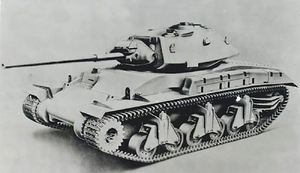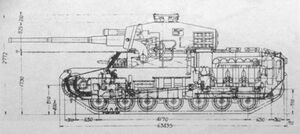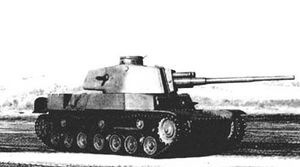Uragano Medium Tank
This article is incomplete because it is pending further input from participants, or it is a work-in-progress by one author. Please comment on this article's talk page to share your input, comments and questions. Note: To contribute to this article, you may need to seek help from the author(s) of this page. |
| CMT Mark IV Uragano | |
|---|---|
 | |
| Type | Medium Tank |
| Place of origin | |
| Service history | |
| In service | 1931 - 1950 |
| Used by | |
| Wars | Siduri War |
| Production history | |
| Designer | Crocetto Heavy Industries |
| Designed | 1929 |
| Manufacturer | Crocetto Heavy Industries, Alenia Industrial, Gabrielli S.p.A. |
| Produced | 1931 - 1945 |
| No. built | ~11,442 |
| Specifications | |
| Weight | 30.0 Tonnes (33 Short Tons; 30 Long Tons) |
| Length | 6.50 m (21 ft 4 in) |
| Width | 2.90 m (9 ft 6 in) |
| Height | 2.90 m (9 ft 6 in) |
| Crew | 5 (Commander, Gunner, Loader, Driver, Radio Operator) |
| Armor | 15—75mm (0.60—3.00 in) |
Main armament | 75mm RA Mark VI Rifled Gun (87 Rounds) |
Secondary armament | 2 x Vitali MG50 (12.7mm; Coaxial and Forward-Mounted) |
| Engine | Crocetto 12-Cylinder Diesel Engine with Supercharger 400 hp |
| Power/weight | 14.0 hp/tonne |
| Transmission | Crocetto TMN Mark II |
| Suspension | Bell Crank |
| Fuel capacity | 500 Liters Internal (132 US Gallons) |
Operational range | 250 km (160 mi) |
| Speed | 45 km/h (28 mph) |
The CMT Mark IV Uragano (English: Hurricane) was a Cacertian medium tank developed during the early 1930s and was used extensively by the Cacertian Imperial Army during the Siduri War in Tyran. It was the most reliable main line tank to be produced by Cacerta during the war and served as the basis for several other fighting vehicles employed by the Royal Army. The Uragano primarily saw service in the Siduri theater, playing a part in the liberation of Lirinya and the defense of the Cacertian Home Islands.
Development
The Uragano was designed by former Royal Army Commander Demetria Marik, a pioneer of motorized tactics for the army prior to the outbreak of the Siduri War. By keeping herself privy to the details of armor development in other nations of Tyran, Demetria came to quickly understand the importance of developing an armored vehicle capable of competing with Cacerta’s contemporaries. It was designed to be able to support the Empire’s lighter tanks developed for the Army’s more mobile form of combat tactics, but also able to stand on its own as an independent armored vehicle.
The first prototype, designed by Demetria, was built in the Crocetto Heavy Industries primary manufacturing plant in Molfetta in 1930. It required a crew of five with the driver and radio operator—who also served the role of forward machine gunner—seated in the front. The remaining three crew members took their positions in the turret, the commander of the tank seated below his roof hatch while the gunner was seated left of the gun breech and the loader to the right. The turret was located on the vehicle’s centerline and the engine compartment situated in the rear.
The Crocetto-built prototype debuted at the Anzio Proving Grounds later that same year with an audience of Royal Army chiefs of staff and army commanders. Following a successful showing, further testing was conducted on the vehicles weaponry and suspension until final approval for production was granted in 1931.
Production
The Uragano was originally planned to supplement the Empire’s lighter and more mobile tanks with appropriate anti-tank firepower and—as a result—Crocetto was the sole manufacturer when the vehicle went into production in 1931. With the start of the Siduri War in 1934, production was extended to include Alenia and Gabrielli facilities throughout the country in as a result of massively successful offensives by the Inner Sphere in the first year of the conflict. An average of 330 tanks were being produced monthly at the outbreak of the war in the Siduri theater and by the end of the war in 1938 approximately 11,442 units had been produced and deployed.
Design
The CMT Mark IV Uragano was a 30 tonne, all-welded medium tank with a maximum front-armor thickness of 75 mm (~3.0 in). It was 6.5 m long without accounting for gun length, 2.9 m high to the top of the turret, and 2.9 m wide. The tank was ideally operated by five crew members which included the tank commander, main armament gunner, loader, driver, and radio operator who also assumed the role of forward gunner. The Mark IV possessed a 400 hp (300 kW) air-cooled 12-cylinder gasoline engine that gave the tank a top speed of 45 km/h on tracks using seven rubber-lined road wheels.
The vehicle’s main armament was the 75mm RA Mark VI rifled AT gun which was capable of firing an armor-piercing shell at a muzzle velocity of 790 m/s. At a range of 2000 m, it was capable of penetrating approximately 86mm of steel armor with a 6.8 kg round. Anti-infantry armament consisted of two MG50 heavy machine guns, one mounted coaxially to the main gun and another mounted in front of the tank’s radio position.

